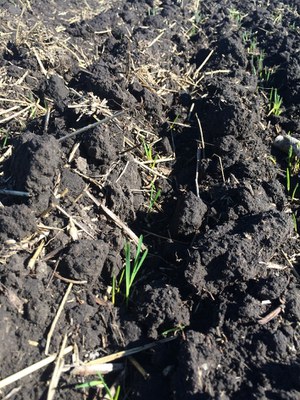Maximizing Nitrogen Fertilizer Value for Wheat in a Dry Spring
The two principal factors affecting crop yields in the Northern Prairies are soil nitrogen (N) supply and available moisture.
Practices to manage soil moisture and N input and supply will depend on many factors that are unique to the farmer - their soil health practices, crop rotation, productivity of the field, economics, etc.
Continue using the NDSU N calculator for spring wheat (https://www.ndsu.edu/pubweb/soils/wheat/). N use efficiency is reduced with plant stress compared to optimum environments, so N fertilizer rate reduction should be conservative.
A few things to consider for this dry spring:
- Without significant rainfall to alter the current soil moisture deficits that could impact production and yields, farmers should consider strategies that minimize soil moisture loss, such as avoiding cultivating the soil prior to seeding. A low soil disturbance, single-pass seeding is likely to achieve some soil moisture conservation.
- Assuming you know how much available N is in your soil, ensure that adequate N is in the soil by the time the young plant is growing. This will enhance root N uptake, root growth deeper in the soil, and uptake of deeper soil moisture.

Young plants require adequate N for proper development
- If you must hope for the best and plan for the worse, plan to ensure your crop does not suffer from N deficiency. Lack of moisture combined with N deficiency stress will be too much for the crop. That means, if your N strategy is to be conservative on N input, consider split application by applying at least 65% of the recommended N before seeding and the rest as sidedress or topdress at rates dependent on the soil moisture status and crop outlook.
- Any N topdress comes with the risk of significant N loss, if anticipated rainfall after application is not sufficient to dissolve the fertilizer and carry the N below the soil surface and roots. To avoid this, consider topdress with a N stabilizer fertilizer containing NBPT such as Agrotain* or SuperU* to provide short-term protection from N loss though conversion to ammonia and volatilization.
- Spring wheat variety decisions have likely been made but if the production season results in lower yields due to dry conditions, there should be reduced plant lodging, reduced foliar and head disease, and increased protein among varieties.
- NDSU recommends starter fertilizer for successful wheat production. Dry soils and presence of salts increase risk of reduced plant stands due to seed injury from direct contact of high concentrations of fertilizer. Consider reducing rates of in-furrow placed fertilizer compared to normal soil conditions. See NDSU Extension circular SF712 “Fertilizing Hard Red Spring Wheat and Durum.”
Jasper Teboh, Ph. D.
Jasper.Teboh@ndsu.edu
Soil Scientist
*NDSU does not endorse commercial products or companies even though reference may be made to tradenames, trademarks or service names.


